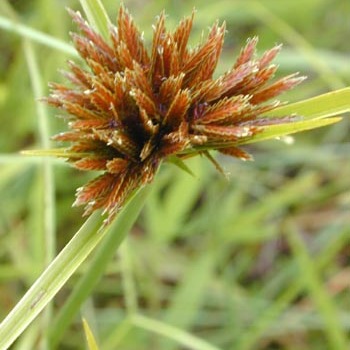Herbs, annual or perennial, cespitose or not, rhizomatous or not, stoloniferous or not. Roots fibrous, principally adventitious. Stems (culms) usually trigonous, occasionally terete, rarely compressed, usually solid, rarely hollow or septate. Leaves basal and/or cauline, alternate, usually 3-ranked, rarely 2-ranked or multi-ranked, bases forming cylindric sheaths enclosing stem, margins usually fused; junction of sheaths and blades often with adaxial flaps of tissue or fringes of hair (ligules); blades frequently absent from some basal leaves, rarely from cauline leaves, when present divergent or ascending, flat, folded, plicate, rolled, or terete, linear, venation parallel. Primary inflorescences (spikelets) a shortened axis; glumaceous bracts (scales) 1–many, spirally arranged, sometimes 2-ranked, usually appressed or ascending; scales usually all fertile, each subtending a single flower, sometimes proximal and/or distal scales empty; lateral spikes often with basal, usually empty, usually 2-keeled scale (prophyll); occasionally prophyll subtending and enclosing rachilla, bearing 1 pistillate, sometimes (0–)3 staminate flowers and empty scales (Carex, Cymophyllus, and Kobresia). Secondary inflorescences panicles, often modified to corymb, pseudoumbel, cyme (anthela), raceme, spike, or capitulum (head), rarely single spike, usually subtended by foliaceous or, less frequently, glumaceous bracts; secondary inflorescences sometimes simulating spikelets (Carex, Cymophyllus, and Kobresia). Flowers hypogynous, bisexual in most genera, unisexual in Scleria, Carex, Cymophyllus, and Kobresia; perianth absent or with (1–)3–6(–30) bristles and/or scales, usually falling off with fruit; stamens usually (1–)3, rarely more, usually distinct; anthers basifixed; pistils 1, 2–3(–4)-carpellate, fused, locule 1; style undivided or branches 2–3(–4); stigma sometimes papillate. Fruits achenes, usually trigonous or biconvex; pericarps thin (except in Scleria). Seeds 1; testa thin, free from pericarp; embryo basal; endosperm abundant. x = 5–ca. 100.
Herbs, annual or perennial, rhizomatous to stoloniferous. Culms (stems) simple, often 3-sided. Leaves basal and/or cauline, often 3-ranked, comprising a blade and sheath but sometimes only sheath present; sheath open or closed; ligule often present, sometimes on opposite side to leaf blade; leaf blade usually linear, grasslike, sometimes basally broader and constricted into a pseudopetiole. Involucral bracts 1 to several, leaflike or glumelike. Inflorescences unbranched and spicate or capitate, to branched and anthelate (umbel-like) or paniculate, comprising 1 to many ultimate inflorescence units, these either indeterminate and called spikelets or in a few genera determinate and called pseudospikelets (see explanation below). Spikelets with 1 to many glumes, sometimes reduced to a single flower and aggregated into unisexual spikes; glumes membranous to leathery, spirally arranged or 2-ranked, each subtending a single flower. Pseudospikelets comprising 2-12 membranous scalelike floral bracts on a much reduced axis; lowest 2 bracts opposite, keeled, pseudospikelet subtended and usually hidden by a glumelike bract; bracts spirally arranged and aggregated into spikeletlike spikes. Flowers bisexual or unisexual with plants monoecious or rarely dioecious. Perianth absent or reduced to bristles or scales. Stamens 1-3; anthers basifixed. Ovary 2-or 3-carpellate, unilocular, with a single ovule; style divided or rarely undivided, base sometimes persistent and variously shaped in fruit; stigmas 2 or 3. Fruit usually a hard 2-or 3-sided nutlet, rarely with a succulent or corky exocarp, surface smooth or variously minutely patterned, sometimes partially or completely enclosed by an enlarged basal prophyll (utricle).
Annuals or caespitose (tufted), rhizomatous, occasionally tuberiferous perennials (Microdracoides is pseudo-arborescent); underground stems bearing scales which grade into the culm leaves; culms generally leafy only at, or towards the base and generally unbranched below the inflorescence, solid, triquetrous, round, flattened or 5-angled; leaves with a distinct cylindrical sheath, closed (except in Coleochloa), generally without a ligule, prolonged at the apex on the side opposite the blade (antiligule) in species of Scleria and Afrotrilepis, and a generally linear blade (reduced to an apiculus in Eleocharis and elsewhere), not articulated with the sheath as in grasses, though deciduous in Coleochloa
Spikelets sometimes solitary (always so in Eleocharis), more often aggregated into capitula, spikes or glomerules which in turn may be solitary or variously arranged, often in 1–3 times compound, unequally rayed umbels, subtended by 1-several, more or less leaf-like, bracts
Flowers small, simple, often consisting only of stamens or pistil or both within a subtending glume, sometimes with accompanying hypogynous bristles, hairs or squamellae, arranged in bisexual or unisexual (Microdracoides, Carex, some Sclerieae) spikelets
Stamens 1-numerous, often 3, anthers basifixed with two pollen sacs often with sterile tips and crest, opening lengthwise by a slit, often protandrous
Ovary superior with one erect anatropous ovule, and generally 2–3 branched style
Fruit indehiscent, nut-like (achene) generally lenticular or trigonous
Seed erect with a small embryo and abundant mealy or fleshy endosperm

